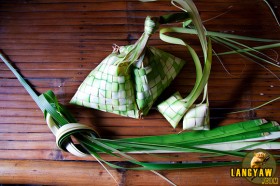

 Speak of Cebu and images of the Sto. Niño , the province’s patron, come to mind. And so does the valiant Lapu-Lapu, sweet mangoes, the famous lechon, guitars and beaches. But it is more than that. Cebu is a special and beautiful place. It is also my home.
Speak of Cebu and images of the Sto. Niño , the province’s patron, come to mind. And so does the valiant Lapu-Lapu, sweet mangoes, the famous lechon, guitars and beaches. But it is more than that. Cebu is a special and beautiful place. It is also my home.
Unless you’re unfortunately bound by the four corners of your hotel room or the idea of a Cebu vacation is limited to resorts, casinos and bars without, for a moment, meeting the man in the street, then I guess, you miss a big part of your touristy junket in this beautiful island province.

Puso, is quite obiquitous and, like the Sto. Nino, lechon and dried mangoes, it is one of Cebu’s iconic images. Nevermind if its also found in some parts of the country, Indonesia and Malaysia in various names, forms and filling.
In the past, this biodegradable, handy and traditional food pouch was said to be exlusively for the deity’s pleasure as it formed part of ritual offerings is now everyday street food paired with barbecued pork, chicken, seafood and entrails in various streetside foodstalls. It’s de rigeur at Larsians near the Fuente Osmena. At an outing at the beach or even at house parties, its still a popular, no fuss choice paired with lechon, dugo-dugo (blood stew), and other Cebuano dishes. For kinamot (eating with the hands sans spoon and fork) dining, I prefer to have puso anytime, anywhere.




Some call it hanging rice although that term is so simplistic considering the intricacy of the weave and the pride that Cebuanos have for this popular fare. Simply, puso is rice cooked inside a woven pouch made from young coconut leaves. The Cebu version is typically called the kinasing owing to its heart shaped form (in the Cebuano language, heart is kasing-kasing). There is also the binaki or froglike form. These comes in various sizes and can cost from P2 for a mouthful (in Larsian but can be cheaper when ordered directly from the puso maker) to as much as P5 for larger ones.
Like what they usually say, you’re trip to Cebu is never complete if you’ve never eaten puso.






Wow nice entry, very detailed story. Nayaya ako minsan sa isa sa mga fiesta sa amin, kung saan ang host ay kapampangan meron din silang nai-serve na ganyan, kaso sa kanila conical (balisuso) yung hugis. Ang sarap yun lang masasabi ko, lalo na kung bagong ani yung bigas.
kaka miss ang puso, daily bread ko na dati sa Opon
Great detailing as usual, estan! Good thing pinayagan kang kunin yung step by step procedure. Parang trade secret yan dba? hehehehe! One of our best locally made-packages. Nagutom tuloy ako.
This really goes well with seafood. I had puso the moment I arrive in Davao for my first Pinoy meal with the family.
is there anyone selling puso here in manila?

i remembered i was seven yrs old when i first ate a puso in cebu, at 4am waiting for the barko to arrive.
puso, “bulad” and hot chocolate.
Joycee, hmm, that I don’t know kung meron ba dito sa manila.
We used to make puso at home for special occasions, but I never quite got the hang of it. Taga-lagay lang ako ng bigas bago i-seal at iluto yung puso. Hehe. We still make our own budbod, though.
@ Joycee – You can find puso in far south tagalog, quezon and bicol makes them – but production is not like the ones that we have there in Cebu
@ Estan – ka miss to’ bai!
Hi estan
I was reading your blog and the comments of friends. I just want you to know that we will be mass producing puso for distribution in Metro Manila para matagbaw ang kahidlaw sa mga sugbuanon ug uban pang mga kaigsoonan nga nangandoy sa availability ini in Metro Manila.
I started with this some six years ago but was forced to stop because of the continued availability of the coco fronds. This time we hope we will be able to sustain the supply for those who are wishing to “bring Cebu over” and satisfy their craving anytime for this delectable pair of puso with pork/chix barbeques, anything sinugba ug uban pa.
I can be contacted at 932-2450 or 359-6162
Wow. They make it in areas in Mindanao where there are predominant Cebuano population. I had puso in Dipolog, Dapitan, Misamis, Polomolok, and Glan. The Cebuano towns of Negros Island like Bais, Tanjay, Malatapay, Zamboanguita and Dumaguete… have puso culture as well. They have various shapes. Dumaguete like the bigger “binalek” shape than the smaller “kinasing” and “binake” of Cebu. Tabuan has the common “binaba” shape while in Anda Bohol, they make a very complicated puso called “binangkito”. It is really very interesting.
I saw above the big sized puso. A professor from Cebu Normal University told me that it is named after an orchid called “manan-aw” . The smaller puso is called in various names: “binake”, “sinayop”, “binaba” or “badbaranay” depending on the area in Cebu.
@elmer, thanx
Nganong wala may puso sa Manila or any part of Luzon? I’ve often wondered…
@chichi, kana pud wa ko kabalo